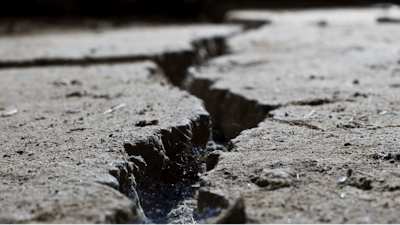
Concrete is a ubiquitous building material, and it is often cited as the most consumed commodity on Earth, second only to potable water.1
As this inherited concrete infrastructure continues to age, maintaining and repairing concrete is of increasing strategic importance to both defense and civilian infrastructure. Missile silos and naval piers, for example, are often many decades old and not easily replaced, and the DoD relies on concrete airfield pavements that are subject to damage from overuse or attack and require rapid repair to maintain high operational tempos.2
Concrete cracking and corrosive deterioration contribute most to degradation and lost serviceability of steel-reinforced structures,3 but current technology is limited to surface treatments that are short-lived and do not address the underlying causes of decay. New research suggests, however, that cross-disciplinary technologies can be used to impart aged concrete with self-healing capabilities.
DARPA recently launched Bio-inspired Restoration of Aged Concrete Edifices, or BRACE. The goal of BRACE is to develop technologies that impart long-lasting, self-healing capability to concrete at depths that address cracks early, to repair them, prevent their propagation, and extend the serviceability of critical infrastructure.
Inspired by the vascular systems that support continuous repair in multicellular organisms and ecosystems, BRACE will develop approaches to integrate a healing “vasculature” for prolonged damage repair and prevention.
The 4.5-year research effort will include two Technical Areas (TAs) focused on developing long-lasting systems for transport of healing substances throughout concrete, as well as practical tools for applying, maintaining, and predicting the long-term function and performance of these systems.
TA1 will address the challenges of engineering bio-inspired approaches for establishing long-acting vascular structures deep within concrete both to repair cracks and to provide self-diagnostic signals that let the user know they are still functioning after years or decades.
In TA2, performers will develop methods for applying and maintaining TA1 systems in concrete, rapid aging testbeds for vascularized concrete, and models that predict the system’s effectiveness in averting the need for future repairs. Performers will respond to both TAs, and BRACE will refine these capabilities in two tracks aligned to repairs on long-term (e.g. steel-reinforced marine or buried infrastructure) and rapid (e.g. expeditionary airfield runway repair) use case timelines.
Although the program will target these use cases, technologies developed in BRACE may eventually be adapted for civilian infrastructure.
BRACE performers will engage with U.S. government and DoD stakeholders, as well as appropriate regulatory authorities. Safety is paramount, and all research will be subject to regular review by both an independent laboratory and regulatory agencies to ensure that BRACE technologies do not pose a threat to human or structural health. In addition, teams are further required to collaborate with ethical, legal, and societal implications (ELSI) experts and ensure the research addresses any related concerns.
A virtual Proposers Day for potential proposers is scheduled for April 13, 2022.
For more information and registration details, visit: https://sam.gov/opp/fea8b749efde4076b4b6c75453991673/view.
A Broad Agency Announcement (BAA) solicitation is expected to available on SAM.gov in the coming weeks.
- Colin R. Gagg. “Cement and concrete as an engineering material: An historic appraisal and case study analysis.” Engineering Failure Analysis, May 2014. https://www.sciencedirect.com/science/article/abs/pii/S1350630714000387#:~:text=Abstract,all%20other%20building%20materials%20combined.
- Haley P. Bell, Benjamin C. Cox, Lulu Edwards, Lyan I. Garcia, Nolan R. Hoffman, Mariely Mejías-Santiago, and Jared L. Johnson Rapid Airfield Damage Recovery Technology Integration Experiment. US Army Corps of Engineers Engineer Research and Development Center. 2019.
- Taffesea, W.Z. and E. Sistonen, Service life prediction of repaired structures using concrete recasting method: state-of-the-art. Procedia Engineering, 2013. 57: p. 1138-1144.






















